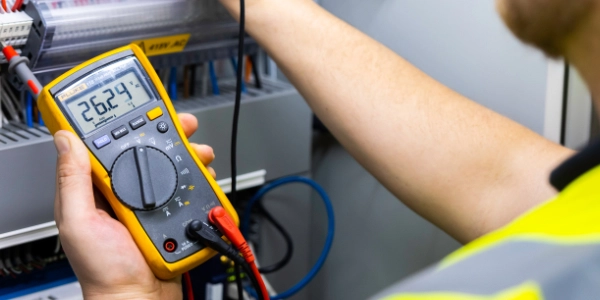Commercial indoor air quality is crucial for ensuring a healthy and productive environment. This guide will explore the importance of indoor air quality, how to assess and improve it, and the regulations governing it.
Understanding commercial indoor air quality
What is commercial indoor air quality?
Commercial indoor air quality refers to the condition of the air within and around commercial buildings, such as offices, retail spaces, hotels, restaurants, warehouses and industrial facilities. It encompasses the health and comfort of building occupants, including various factors that affect the air quality, such as the presence of pollutants, ventilation effectiveness, temperature and humidity levels. Maintaining good commercial indoor air quality is crucial for the well-being of employees, customers and visitors, and it can significantly impact productivity, absenteeism and overall satisfaction in a business environment.
Assessing commercial indoor air quality
Commercial indoor air quality testing
Commercial indoor air quality testing is crucial to identify and mitigate pollutants, ensuring a safe, healthy and comfortable environment for employees and customers, thereby enhancing productivity and complying with regulations.
Testing commercial indoor air quality involves several steps to identify and measure pollutants, and assess ventilation effectiveness. The process includes:
- Initial assessment – conducting a walkthrough of the facility to identify potential sources of pollution and evaluate the HVAC system. This includes observing airflow patterns, checking for moisture issues and identifying areas with odours or visible pollutants.
- Sampling – collecting air samples using specialised equipment to measure common pollutants, such as volatile organic compounds (VOCs), particulate matter (PM), carbon monoxide, carbon dioxide and biological contaminants (e.g., mould spores, bacteria).
- Data analysis – analysing the collected samples in a laboratory to determine the concentration of pollutants. Advanced testing may involve real-time monitoring using sensors for continuous data.
- Ventilation assessment – evaluating the ventilation system’s performance, including air exchange rates and filtration efficiency, to ensure adequate fresh air supply and pollutant removal.
- Report and recommendations – receipt of a report detailing findings, potential health risks and recommendations for improving indoor air quality, such as enhancing ventilation, reducing pollutant sources and maintaining HVAC systems.
Using Indoor Air Quality Services
Professional services can provide expert assessments, precise air quality testing and tailored solutions to address specific issues. They will issue a detailed report, featuring any recommended improvements, such as enhanced ventilation or filtration, to ensure compliance with regulations, create a healthier indoor environment and optimise air quality for commercial spaces.
Regular indoor air quality assessments not only improve health by identifying pollutants and enhancing comfort, they also save costs by preventing equipment issues and extending the life of the HVAC system.
How to improve indoor air quality
Steps to improve commercial indoor air quality
Here are some key strategies to consider in order to ensure a healthier environment for occupants and enhance overall building performance:
- Increase ventilation
Proper ventilation dilutes indoor pollutants and brings in fresh external air. Ensure that ventilation systems, including HVAC units and exhaust fans, are adequately designed and functioning properly. - Implement green building materials
Opt for low-emission, environmentally-friendly building materials and furnishings. For example, low-VOC paints, sustainable flooring and non-toxic adhesives reduce the release of harmful chemicals into the air. Additionally, incorporating houseplants can naturally filter air, while also enhancing the aesthetics of a space. - Regular maintenance of HVAC systems
HVAC systems that are regularly inspected and maintained will continue to operate efficiently. This includes changing filters, cleaning ducts and checking for leaks or blockages. Proper maintenance helps prevent the build-up of dust and mould, which can contribute to poor air quality.
Controlling indoor air quality
There are two key, regular strategies to maintaining a healthy environment. They are:
- Monitoring air quality – use sensors and monitors to continuously track levels of pollutants, humidity and temperature. This helps identify issues before they become significant problems.
- Responding to changes – be proactive in addressing any changes in air quality. Adjust ventilation, increase cleaning frequency or address any identified sources of pollution promptly.
Effective and regular commercial indoor air quality assessment and prompt action not only ensure a safe and comfortable environment but also contribute to the overall efficiency and longevity of commercial spaces.
Indoor air quality regulations
In the UK, indoor air quality is governed by various regulations and standards aimed at protecting public health and ensuring a safe indoor environment. Here’s an overview of the key regulations and guidelines:
The Building Regulations 2010
‘Part F’ of the Building Regulations, specifically the ‘Ventilation’ section, provides guidance for adequate ventilation in new buildings and when work is done to existing ones. This includes minimum ventilation rates and performance-based ventilation, i.e. optimising ventilation systems based on performance metrics and real-time data to prevent issues such as moisture and indoor pollution.
HSE guidance and codes of practice
The Health and Safety Executive (HSE) provides guidance and codes of practice related to indoor air quality and workplace safety. These documents offer practical advice on maintaining good indoor air quality and managing risks associated with indoor air pollutants.
European Union regulations and standards
Although the UK has left the EU, many standards and guidelines previously adopted from EU regulations still influence indoor air quality practices. In particular, the 2016 National Emission Ceilings Directive, sets 2030 emission reduction commitments for five main air pollutants, including nitrogen oxides (NOx), non-methane volatile organic compounds (NMVOCs), sulphur dioxide (SO2), ammonia (NH3) and fine particulate matter (PM2.5).
The Workplace (Health, Safety and Welfare) Regulations 1992 & Health and Safety at Work Act 1974
The 1992 Workplace Regulations require employers to maintain a comfortable working environment to ensure that every enclosed workplace is ventilated by a sufficient quantity of fresh or purified air.
The 1974 Health and Safety at Work Act, at a very foundational level, requires employers to ensure, so far as reasonably practicable, the health, safety and welfare of employees. This includes maintaining a safe and healthy working environment, which encompasses adequate indoor air quality.
Control of Substances Hazardous to Health Regulations 2002
The Control of Substances Hazardous to Health (COSHH) Regulations 2002 require employers to assess and control the risks associated with hazardous substances, including those that can affect indoor air quality, such as chemical fumes, dust and biological agents. Employers must ensure that exposure to harmful substances is minimised.
The importance of maintaining good indoor air quality in commercial spaces
Maintaining good commercial indoor air quality is vital for employee health, productivity and overall well-being. It reduces health risks, enhances comfort and boosts workplace efficiency. Additionally, it ensures regulatory compliance and can lower operational costs by improving energy efficiency and extending the lifespan of HVAC systems.
Cube Controls is an established and experienced supplier of Building Management Systems, specialising in the design and set up of bespoke environmental and energy control programmes for commercial buildings and property.
To find out how Cube Controls can support you at all stages of design and consultancy, installation and modification and maintenance of your building management systems contact our expert and friendly team on 01903 694279 or sales@cubecontrols.co.uk.




